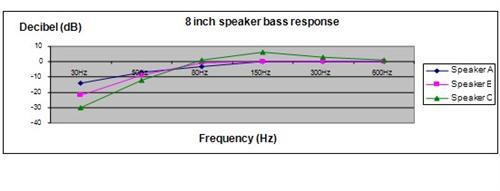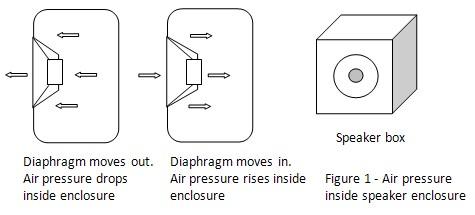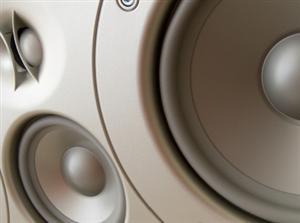| Complexity level: | 7 |
| Project cost ($): | 90 |
| Time required: | 2 days to prepare, 1 day for experiment |
| Material availability: | Easily found. May be purchased at a hardware store (eg. Home Depot) |
| Safety concerns: | None |
Hypothesis
Reducing the size of the speaker enclosure will cause the dB of some frequencies to be higher compared to the rest of the frequencies.
Overview
Speakers
The speaker consists of an enclosure, a driver and a crossover. The speaker enclosure is normally made from hard wood like plywood or MDF (Medium Density Fiber). The enclosure will help to hold the speaker driver in place and also absorb the vibrations from the driver.

The diaphragm of the driver moves back and forth to create sound. The forward movement of the diaphragm will cause the air pressure inside the enclosure to drop and the backward movement of the diaphragm will cause the pressure inside the enclosure to rise.
Scientific Terms
Materials
The materials required for this science fair project:
- 3 pieces of plywood measuring 1meter x 1meter
- Hammer and nails (quantity as required)
- Glue
- Silicon filler
- Three 8-inch speakers
- Electric drill and drill bits
- Saw
- Decibel meter
- CD player
- Test CD with various audio frequencies
Procedure
1. For this experiment, the independent variable is the side of the enclosure and audio frequency played. The dependent variable is the decibel reading of the frequency. The reading is measured using a Decibel meter. The constants (control variables) are the materials used to construct the speaker, the size of the speaker and the distance of the decibel meter from the speaker.
2. The plywood planks are cut and constructed according to the speaker enclosure sizes shown in figure 2. The speakers are marked A for 500mm depth, B for 400mm depth and C for 300mm depth. The plywood planks are constructed into the enclosure sizes using glue and nails.
3. The areas where the two plywood pieces meet are sealed using silicon filler to make the enclosure air tight. Using a drill and saw, an 8-inch hole is cut in the center of the enclosure to mount the driver.

4. A small hole is made at the back of the enclosure using the drill. The wire from the speaker driver is taken out through this hole and connected to the CD player.
5. The decibel meter is placed 1 meter in front of the speaker A. The speaker wire from enclosure A is connected to the CD player. The CD player is made to generate audio sounds at 30Hz, 50Hz, 80Hz, 150Hz, 300Hz and 600Hz. The reading on the decibel meter is recorded in the table below.
6. The procedure above (Step 5) is repeated using speaker B and speaker C. The results are all recorded in the table below.




Results
The results show that the frequency response of speakers A and B does not go beyond the 0 dB level, but the smallest speaker C will produce some frequencies that are louder than the others. These frequencies show a response reading higher than 0dB.
Speaker |
dB reading taken at decibel meter |
|||||
30Hz |
50Hz |
80Hz |
150Hz |
300Hz |
600Hz |
|
Speaker A |
-14 |
-7 |
-3 |
0 |
0 |
0 |
Speaker B |
-22 |
-9 |
-1 |
0 |
0 |
0 |
Speaker C |
-30 |
-12 |
1 |
6 |
3 |
1 |
The graph below represents the results of our science project experiment.

Conclusion
The hypothesis that reducing the size of the speaker enclosure will cause the dB of some frequencies to be higher is proven to be true.
With a depth of 300mm the sound of speaker C at the 150Hz frequency was 6 times louder than the sound level of the other speakers.
This type of air tight speaker enclosure is called a sealed enclosure. When the diaphragm of the speaker moves in, the air pressure will build up inside the speaker enclosure and push the diaphragm back out. Similarly if the diaphragm of the speaker moves out, the air pressure inside the enclosure will drop and pull the diaphragm back. This spring like effect will cause the sound produced to be more precise. However the audio electrical signal will need more boosting by the amplifier circuit.
Also consider
The experiment can also be done by checking the frequency response using different types and thickness of wood for the enclosure.
This experiment can also be repeated using different sizes of speakers.
References
Speaker enclosure design - http://www.niksula.hut.fi/~mdobruck/siililand/mini/diy/alien/ice/speaker.html
How speakers work - http://electronics.howstuffworks.com/speaker9.htm

